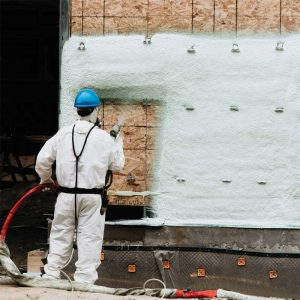Next-gen sprayfoam systems: Shifting to HFO blowing agents

Producers dissolve the blowing agent into foam precursors where it expands to form the foam once injected or sprayed, causing the foaming reaction to begin. Optimization is crucial to ensure thermal efficiency and overall performance. Foam blowing agents with low thermal conductivity can improve insulation properties of the foam, allowing better insulation performance or thinner profiles for the same insulation value. The committee further points out how emissions of the foam blowing agent from closed cell foam are typically less than two percent annually, so this thermal performance persists over time.
The evolution of blowing agents
Blowing agents used in SPFs have evolved over time, with the phase out of specific compounds occurring at various points in the past. The first class of blowing agents used in sprayfoam were chlorofluorocarbons (CFCs). They have a global warming potential (GWP) of more than 4000 and an ozone depletion potential (ODP) of one. Second generation blowing agents
were hydrochlorofluorocarbons (HCFCs), which have a GWP
of more than 725 (and can range up to 2310) and an ODP of approximately 0.055 to 0.11. The U.S. government banned CFCs in 1996 because of their ability to degrade the Earth’s ozone layer. It later banned HCFCs in 2005 for the same reason.
HFCs are the third iteration of sprayfoam blowing agents and are still in use today. They offer zero ODP; however, have a GWP value of more than 794 (and up to 3220). Once considered a suitable replacement for ozone-depleting substances, HFCs are now the world’s fastest-growing greenhouse gases. HFCs have up to 4000 times more global warming impact than carbon dioxide (CO2). Scientists estimate HFCs alone could contribute up to 0.5 C (32.9 F) of global warming by the end of the century.
It is for this reason the industry is shifting towards the use of HFOs, which offer zero ODP and a GWP value of less than 25. Pending the blowing agent in question, some HFOs offer a GWP value of one. Note the dramatic difference in GWP between first generation blowing agents (CFCs) and the new, fourth generation of blowing agents (HFOs)—an initial GWP of over 4,000 to a GWP of just 1 today.
A defining moment: 1987’s Montreal Protocol
An international effort to protect the Earth is the backdrop for the periodic phase out of specific sprayfoam blowing agents. This effort began as an effort to slow the loss of stratospheric ozone when, in 1987, the international community signed the original Montreal Protocol. The agreement mandated that developed countries begin phasing out the use of Chlorofluorocarbons (CFCs), which are known to destroy the Earth’s ozone layer. This agreement called for participating countries to achieve a 50 percent reduction in the use of CFCs relative to 1986 levels by 1998. The Montreal Protocol was essentially the world’s first step of many in protecting the ozone layer.
However, after this international treaty was signed, new data became available that demonstrated worse than expected ozone layer damage. This data ultimately led to a series of amendments to the initial agreement, all of which were aimed at controlling additional ozone depleting chemicals and identifying mechanisms to enforce the compliance of developing countries. The amendments, in sequential order, include the London Amendment in 1990, the Copenhagen Amendment in 1992, the Montreal Amendment in 1997, the Beijing Amendment
in 1999, and the Kigali Amendment in 2016.
The latter amendment is notable as its goal was to phase down the production and use of HFCs. It aimed to address the fact the use of HFCs results in greenhouse gases known to be incredibly detrimental to the Earth’s climate. At the time of the amendment’s ratification, U.S. President Barack Obama and his administration strongly supported the effort.



